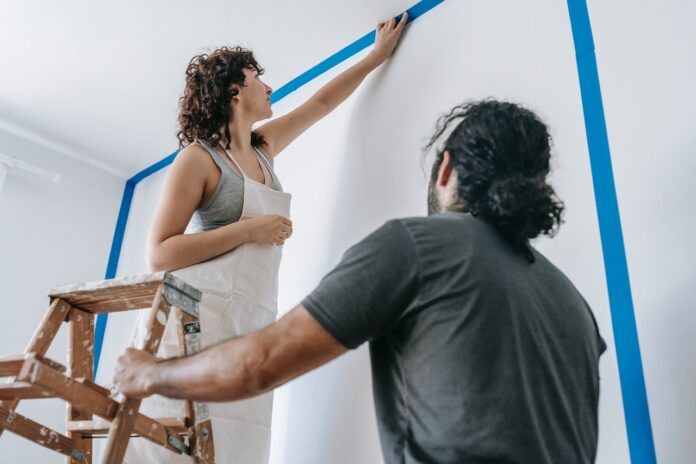We here at IDEAL think there’s nothing better in these harsh winter months than curling up with a good book (and a glass of wine, of course) in front of our wood burning stove. The heat is incredible, the atmosphere it creates even warmer, and the smell simultaneously soothingly nostalgic and exciting. It’s hypnotic to look at, too.
But – isn’t there always a but? – getting one lit and firing on all cylinders, as it were, takes practice and skill.
This isn’t flick-on-the-switch stuff, that’s for sure, and to get the most out of your log burner, you need to light it correctly. With that in mind, we asked Christine Matthews from Gr8Fires, the online store specialising in stoves, log burners, and fireplaces, how to ensure your fire not only ignites swiftly but also endures for as long as possible. Here’s what she said…
Preparation: The Key To A Lasting Fire
The secret to a long-lasting fire lies in the preparation. Much like a marriage, a well-prepared log burner is safer, more efficient, and easier to manage. Here’s how to get yours flame-ready.
Choosing Your Wood
Selecting the right type of wood is crucial:
- Hardwoods: Opt for hardwoods like oak, ash, or beech. These dense woods take longer to burn through than softwoods, providing a steady release of heat over a longer period.
- Seasoning: The wood should be well-seasoned, meaning it has been left to dry for at least a year, reducing its moisture content to below 20%. This ensures it burns hotter and produces less creosote, which can clog your chimney.
- Storage: Keep your wood in a dry, ventilated space to prevent it from absorbing moisture.
Read: 9 ideas for decorating your home with firewood
Setting The Stage
A clean and well-arranged firebox is the foundation of a good fire, make no mistake:
- Clean the Firebox: Begin with an ash-free firebox, but leave an inch of ash to act as an insulating layer, which helps in retaining heat.
- Check the Air Vents: Fully open the air vents to maximize the oxygen flow, which is vital for the initial ignition.
- Create a Fire Bed:
- Firelighter Placement: Position a firelighter or a bundle of newspaper in the centre of the grate.
- Kindling Structure: Surround the firelighter with a lattice of kindling. This should be arranged in a way that resembles a tepee or a grid, allowing air to circulate freely and the flames to spread evenly.
Read: How to make a gas fireplace look stylish and subtle
Lighting The Fire: Patience & Precision
The lighting process is where your patience is tested, but it’s also where the magic begins. There’s just something so primeval about it, don’t you think? Here’s how to light up with agility…
The Initial Ignition
- Light the Firelighter: Ignite the firelighter or newspaper with a long match or lighter, ensuring you don’t burn yourself.
- Allow Airflow: Keep the air vents fully open to facilitate airflow and feed the growing flames with oxygen.
- Add More Kindling: Once the kindling starts to burn with a steady flame, add a few more pieces, one at a time, to build a strong base of embers.
Building The Fire
- Gradual Addition: Wait until the kindling has formed a solid ember base before introducing larger logs.
- Formation: Place two logs parallel to each other with a space in between, and then lay another log on top to create a ‘log cabin’ structure. This allows for good air circulation, which is key to maintaining the fire.
- Monitor and Adjust: Keep a close eye on the fire. If it seems to be dwindling, gently move the logs to improve airflow, but be careful not to disrupt the ember bed.
Maintaining The Burn: A Watchful Eye
A well-maintained fire can last for hours, providing consistent warmth and comfort. Here’s how to keep things ticking (or should that be ‘flickering’?) along…
Controlling Airflow
- Adjust the Vents: Once the logs are burning well, you can start to control the burn rate by slightly closing the vents. This reduces the airflow, which in turn slows down the burn rate.
- Finding the Sweet Spot: Each log burner has its own characteristics, and finding the optimal airflow for your specific model will require some trial and error.
Adding Fuel
- Timing: Only add more logs when the previous ones have burned down to a bed of embers. This is the best time to introduce new fuel as the heat is at its most intense.
- Log Placement: Add logs one or two at a time, ensuring they’re placed to allow for continued airflow. Overloading can smother the fire and cause it to go out.
- Regular Checks: Keep an eye on the fire, adding logs as necessary but always prioritizing airflow to maintain a steady burn.
Read: 7 ways to add warmth to your home decor
Safety & Efficiency: The Final Considerations
Fire safety should never be compromised, and efficiency should always be sought after, not just in fire lighting, but in life. Anyway, here’s how to nurture the former (the latter, we know nothing about):
Safety First
- Use a Fire Guard: A fire guard is essential if you’re not in the room, as it prevents sparks from escaping and potentially starting a fire.
- Smoke Alarms: Make sure you have functioning smoke and carbon monoxide detectors installed in your home, and test them regularly.
Efficiency Matters
- Regular Maintenance: Keep your log burner and chimney clean. A build-up of soot or creosote can significantly reduce the efficiency of your burner and increase the risk of a chimney fire.
- Burn Wisely: Only burn wood that is appropriate for your log burner. Never burn treated, painted, or wet wood, as these can release harmful toxins and create excessive smoke.
Are Log Burners Banned In The UK?
With the increasing focus on air pollution and environmental concerns, many people in the UK are asking whether log burners are banned. The simple answer is no, log burners are not banned in the UK. However, there are important regulations and guidelines in place that you need to be aware of to use a log burner legally and responsibly.
Understanding the Regulations
The UK government has introduced measures to reduce emissions from domestic burning, primarily through the Clean Air Act and its subsequent amendments. These regulations are designed to combat air pollution and promote cleaner air.
Defra-Approved Stoves
In certain areas, known as ‘Smoke Control Areas’, you can only use log burners that meet specific emission standards set by the Department for Environment, Food & Rural Affairs (Defra). These stoves are known as ‘Defra-approved’ or ‘Exempt’ stoves and are designed to burn wood more cleanly and efficiently, producing less smoke.
The EcoDesign Regulations
As of 2022, new stoves sold in the UK must comply with the EcoDesign regulations. These are a set of European-wide regulations that aim to lower emissions and improve air quality. Stoves that meet these requirements are even more efficient and clean-burning than the current Defra-approved models.
Fuel Restrictions
The type of fuel you can burn is also regulated. In Smoke Control Areas, you cannot burn wood or coal unless it’s on the list of authorised fuels or you’re using an exempt appliance. Outside of these areas, it’s still recommended to use cleaner fuels to reduce pollution.
What This Means For Log Burner Users
If you have an older stove, it’s worth checking whether it meets current standards. While existing stoves are not banned, upgrading to a newer, more efficient model can have benefits for both the environment and your home’s heating efficiency. It’s also essential to ensure that you’re using the correct type of fuel, ideally wood that is well-seasoned and has a low moisture content.
Indeed, whilst the UK government is not banning log burners, it is encouraging cleaner practices. By understanding and adhering to these regulations, you can enjoy the warmth and ambiance of a log burner while minimizing its environmental impact. It’s all about burning the right material, in the right appliance, and in the right way.
The Bottom Line
By meticulously following these steps, you can light your log burner in a manner that not only provides immediate warmth and ambiance but also ensures a lasting, safe, and efficient fire. So, stoke up the burner, sit back, and enjoy the enduring comfort of a well-lit fire that will see you through the coldest of evenings.





